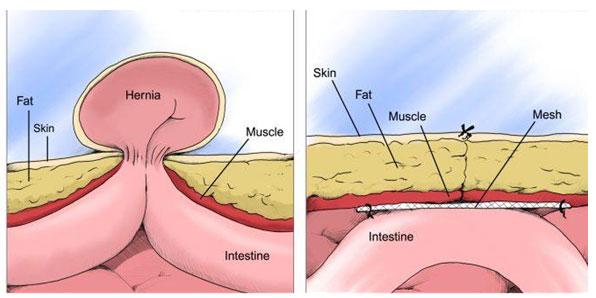Hernia Surgery
What is a hernia?
A hernia occurs when the inside layers of the abdominal wall weaken then bulge or tear. The inner lining of the abdomen pushes through the weakened area to form a balloon-like sac. This, in turn, can cause a loop of intestine or abdominal tissue to slip into the sac, causing severe pain and other potentially serious health problems.
Men and women of all ages can have hernias. Hernias usually occur either because of a natural weakness in the abdominal wall or from too much strain on the abdominal wall, such as:
Strain from heavy lifting;
Gaining a great deal of weight;
Persistent coughing; or
Difficulty with bowel movements or urination.
Eighty percent of all hernias are located near the groin. Hernias might also be found below the groin (femoral), through the navel (umbilical), and along an earlier incision, or cut (incisional).
What are the symptoms of hernias?
The symptoms of hernias include the following:
A noticeable bulge in the groin area or in the abdomen.
Feeling pain while lifting.
A dull aching or burning sensation.
A vague feeling of fullness.
Nausea and constipation.
What happens during Open Hernia Surgery?
An anesthesiologist (a doctor who specializes in sedation and pain relief) gives you general anesthesia, which relaxes your muscles and induces sleep. You will not feel pain during the surgery.
A small incision, or cut (from 1 to 3 cm, approximately 1/3 inch to 1 ¼ inch), is made near the hernia.
The hernia "sac" containing the bulging intestine is identified.
The surgeon pushes the intestine back into its proper place behind the muscle wall.
The hernia sac is removed.
The muscle wall is reinforced with multiple layers of stitches to prevent another hernia.
The skin around the hernia is closed.
Most patients will be able to go home a few hours after surgery. However, patients with certain medical conditions may need to spend one night in the hospital for observation.
How is a laparoscopic hernia repair performed?
Laparoscopic surgery uses a laparoscope, a thin, telescope-like instrument that is inserted through a small incision at the belly button. This procedure is usually performed under general anesthesia, so before the surgery, you will need to have an evaluation of your general state of health – including a history and physical exam (possibly including lab work) and an EKG.
You will not feel pain during this surgery. The laparoscope is connected to a tiny video camera, smaller than a dime, that projects an "inside view" of your body onto television screens in the operating room. The abdomen is inflated with a harmless gas (carbon dioxide), which creates space to allow your doctor to view your internal structures. Mesh is placed on the inside to cover the defects in the abdominal wall and strengthen the tissue.
After the procedure is completed, the small abdominal incisions are closed with a stitches or with surgical tape. Within a few months, the incisions are barely visible.
What are the benefits of laparoscopic hernia surgery?
The benefits of laparoscopic hernia surgery include the following:
Several tiny scars rather than 1 large abdominal incision.
A short hospital stay. You might leave the day of surgery or the day after surgery.
Reduced pain after the surgery.
Low hospital costs.
Faster return to work.
Shorter recovery time (days instead of weeks).
Earlier return to daily activities.
What can I expect after hernia surgery?
It is important to follow your doctor's instructions after hernia surgery. Many people feel better in just a few days. However, you might need to take it easy for a week or two. You may be given lifting restrictions for up to several months after surgery depending on your type of daily activity and the location of your hernia surgery. You should monitor your incision daily for signs of infection, and call our office if you are worried about anything.
